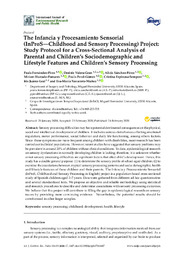Por favor, use este identificador para citar o enlazar este ítem:
https://hdl.handle.net/11000/31287Registro completo de metadatos
| Campo DC | Valor | Lengua/Idioma |
|---|---|---|
| dc.contributor.author | Fernández Pires, Paula | - |
| dc.contributor.author | Valera-Gran, Desirée | - |
| dc.contributor.author | Sánchez-Pérez, Alicia | - |
| dc.contributor.author | HURTADO-POMARES, MIRIAM | - |
| dc.contributor.author | Peral-Gómez, Paula | - |
| dc.contributor.author | Espinosa-Sempere, María Cristina | - |
| dc.contributor.author | Juárez Leal, Iris | - |
| dc.contributor.author | Navarrete-Muñoz, Eva María | - |
| dc.contributor.other | Departamentos de la UMH::Patología y Cirugía | es_ES |
| dc.date.accessioned | 2024-02-08T11:46:27Z | - |
| dc.date.available | 2024-02-08T11:46:27Z | - |
| dc.date.created | 2020-02-24 | - |
| dc.identifier.citation | Int J Environ Res Public Health. 2020 Feb 24;17(4) | es_ES |
| dc.identifier.issn | 1660-4601 | - |
| dc.identifier.issn | 1661-7827 | - |
| dc.identifier.uri | https://hdl.handle.net/11000/31287 | - |
| dc.description.abstract | Sensory processing difficulties may have potential detrimental consequences on the physical, social and intellectual development of children. It includes serious disturbances affecting emotional regulation, motor performance, social behavior and daily life functioning, among others factors. Since these symptoms are more frequent among children with disabilities, most research has been carried out in clinical populations. However, recent studies have suggested that sensory problems may be prevalent in around 20% of children without clinical conditions. To date, epidemiological research on sensory dysfunctions in normally developing children is lacking; therefore, it is unknown whether or not sensory processing difficulties are significant factors that affect child's development. Hence, this study has a double general purpose: (1) to determine the sensory profile of school-aged children; (2) to examine the associations between atypical sensory processing patterns and socio-demographic, health and lifestyle features of these children and their parents. The Infancia y Procesamiento Sensorial (InProS, Childhood and Sensory Processing in English) project is a population-based cross-sectional study of Spanish children aged 3-7 years. Data were gathered from different ad hoc questionnaires and several standardized tests. We propose an objective and reliable methodology using statistical and research procedures to describe and determine associations with sensory processing outcomes. We believe that this project will contribute to filling the gap in epidemiological research on sensory issues by providing more convincing evidence. Nevertheless, the potential results should be corroborated in other larger samples. | es_ES |
| dc.format | application/pdf | es_ES |
| dc.format.extent | 9 | es_ES |
| dc.language.iso | eng | es_ES |
| dc.publisher | MDPI | es_ES |
| dc.rights | info:eu-repo/semantics/openAccess | es_ES |
| dc.rights | Attribution-NonCommercial-NoDerivatives 4.0 Internacional | * |
| dc.rights.uri | http://creativecommons.org/licenses/by-nc-nd/4.0/ | * |
| dc.subject | sensory processing | es_ES |
| dc.subject | childhood | es_ES |
| dc.subject | development | es_ES |
| dc.subject | health | es_ES |
| dc.subject | lifestyle | es_ES |
| dc.title | The Infancia y Procesamiento Sensorial (InProS—Childhood and Sensory Processing) Project: Study Protocol for a Cross-Sectional Analysis of Parental and Children’s Sociodemographic and Lifestyle Features and Children’s Sensory Processing | es_ES |
| dc.type | info:eu-repo/semantics/article | es_ES |
| dc.relation.publisherversion | https://doi.org/10.3390/ijerph17041447 | es_ES |

Ver/Abrir:
The Infancia y Procesamiento Sensorial (InProS—Childhood and Sensory Processing) Project. Study Protocol for a Cross-Sectional Analysis.pdf
309,99 kB
Adobe PDF
Compartir:
 La licencia se describe como: Atribución-NonComercial-NoDerivada 4.0 Internacional.
La licencia se describe como: Atribución-NonComercial-NoDerivada 4.0 Internacional.
.png)